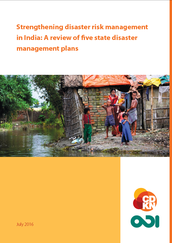Strengthening disaster risk management in India: a review of five state disaster management plans
 India has suffered from many disasters in its recent history, both natural and climate-related, and these continue to cause devastation. In November 2015, floods in the southern city of Chennai, Tamil Nadu, killed over 370 people and damaged crops worth US$190 m. And in May 2016, at the time of writing this report, record temperatures of 51°C hit Phalodi, Rajasthan, during a heat wave that affected much of northern India. In the face of these diverse and repeated hazards, Indian authorities, from the national to the state level, have taken a series of actions to improve their management of disasters. One of the foremost policies enacted has been the development of state disaster management plans (known as SDMPs). All states in the country are required to produce these documents, which outline the preparations, risk-reduction actions and responses needed to reduce and cope with the threats specific to their region. But how effective are these plans in ensuring states are better able to prepare for, and respond to, disasters? This research analyses in detail the SDMPs from five very different states (in terms of climate, geography, size and location): Assam, Bihar, Gujarat, Odisha and Uttarakhand.
India has suffered from many disasters in its recent history, both natural and climate-related, and these continue to cause devastation. In November 2015, floods in the southern city of Chennai, Tamil Nadu, killed over 370 people and damaged crops worth US$190 m. And in May 2016, at the time of writing this report, record temperatures of 51°C hit Phalodi, Rajasthan, during a heat wave that affected much of northern India. In the face of these diverse and repeated hazards, Indian authorities, from the national to the state level, have taken a series of actions to improve their management of disasters. One of the foremost policies enacted has been the development of state disaster management plans (known as SDMPs). All states in the country are required to produce these documents, which outline the preparations, risk-reduction actions and responses needed to reduce and cope with the threats specific to their region. But how effective are these plans in ensuring states are better able to prepare for, and respond to, disasters? This research analyses in detail the SDMPs from five very different states (in terms of climate, geography, size and location): Assam, Bihar, Gujarat, Odisha and Uttarakhand.
